Human Behaviour Analysis: Inaccurate Perceptions, Biases, Solutions
VerifiedAdded on 2020/12/29
|6
|1186
|495
Report
AI Summary
This report analyzes human behavior within an organizational context, specifically focusing on the Infratil limited company. It explores three key areas: inaccurate perceptions, common decision-making biases, and potential solutions to mitigate these biases. The report identifies three ways inaccurate perceptions can form, including attitude, attention, and cultural influences. It then examines three common decision-making biases: overconfidence bias, availability bias, and confirmation bias, providing examples of how these biases impact decision-making. Finally, the report suggests strategies to reduce these biases, such as focusing on organizational goals and providing relevant information to employees, ultimately aiming to improve decision-making processes and foster positive human behavior within the organization.
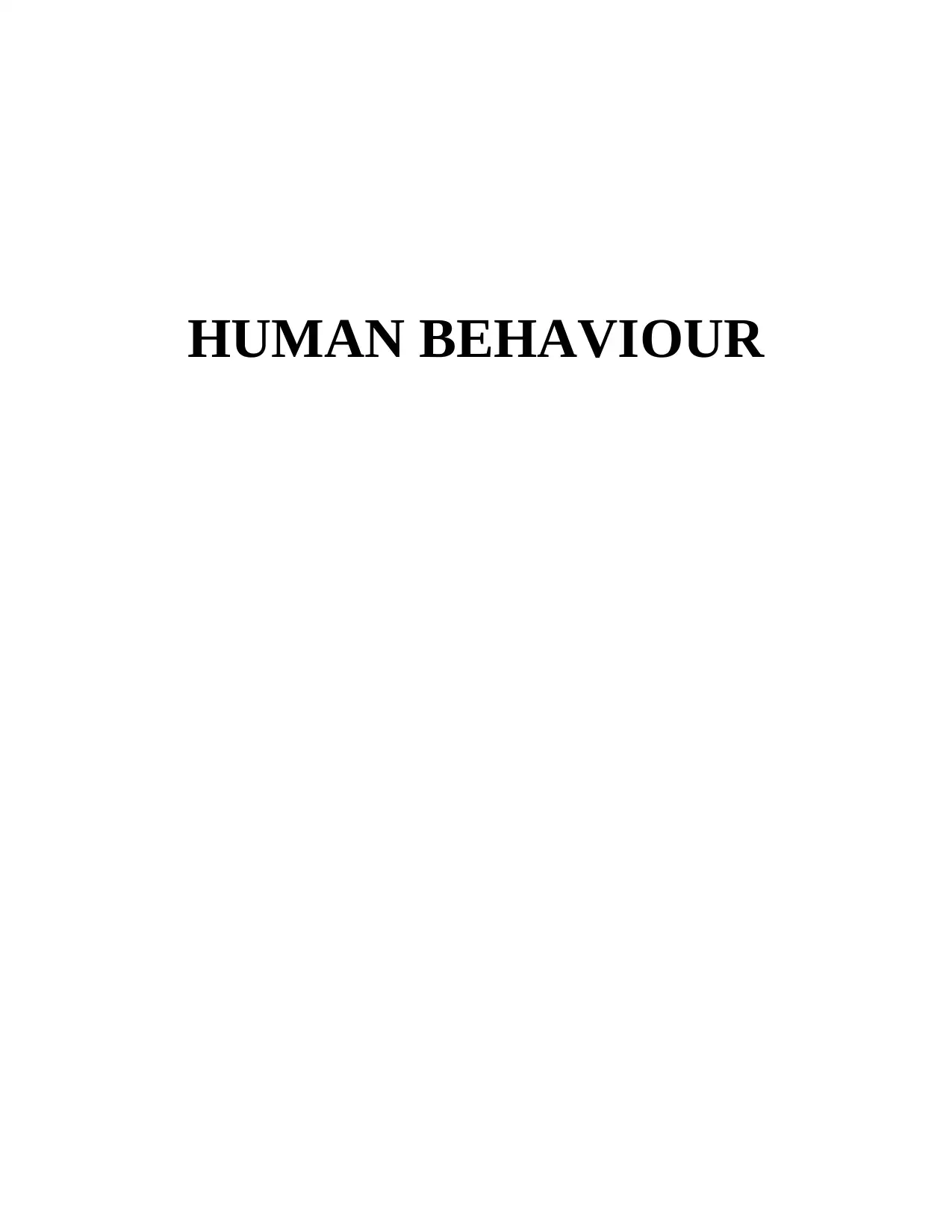
HUMAN BEHAVIOUR
Paraphrase This Document
Need a fresh take? Get an instant paraphrase of this document with our AI Paraphraser
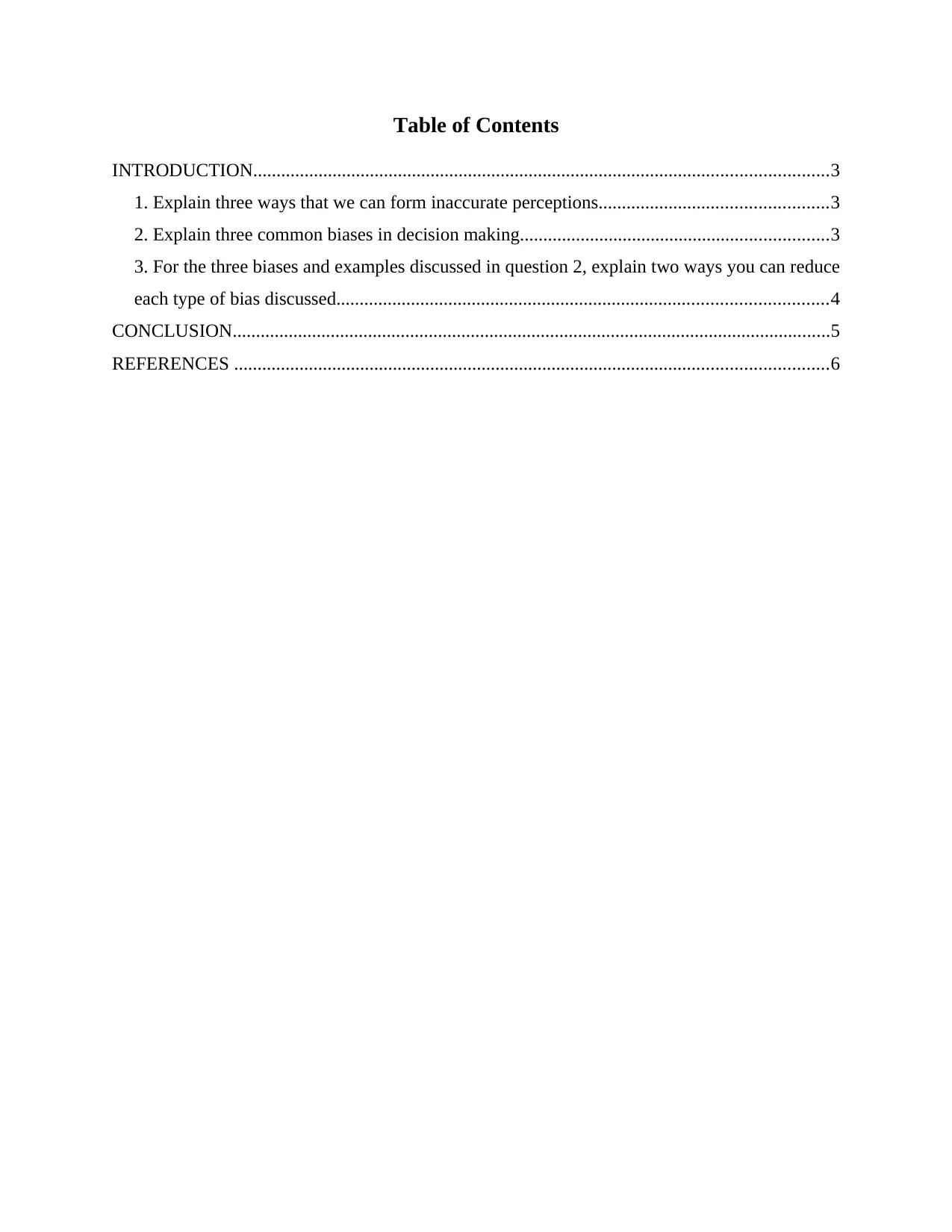
Table of Contents
INTRODUCTION...........................................................................................................................3
1. Explain three ways that we can form inaccurate perceptions.................................................3
2. Explain three common biases in decision making..................................................................3
3. For the three biases and examples discussed in question 2, explain two ways you can reduce
each type of bias discussed.........................................................................................................4
CONCLUSION................................................................................................................................5
REFERENCES ...............................................................................................................................6
INTRODUCTION...........................................................................................................................3
1. Explain three ways that we can form inaccurate perceptions.................................................3
2. Explain three common biases in decision making..................................................................3
3. For the three biases and examples discussed in question 2, explain two ways you can reduce
each type of bias discussed.........................................................................................................4
CONCLUSION................................................................................................................................5
REFERENCES ...............................................................................................................................6
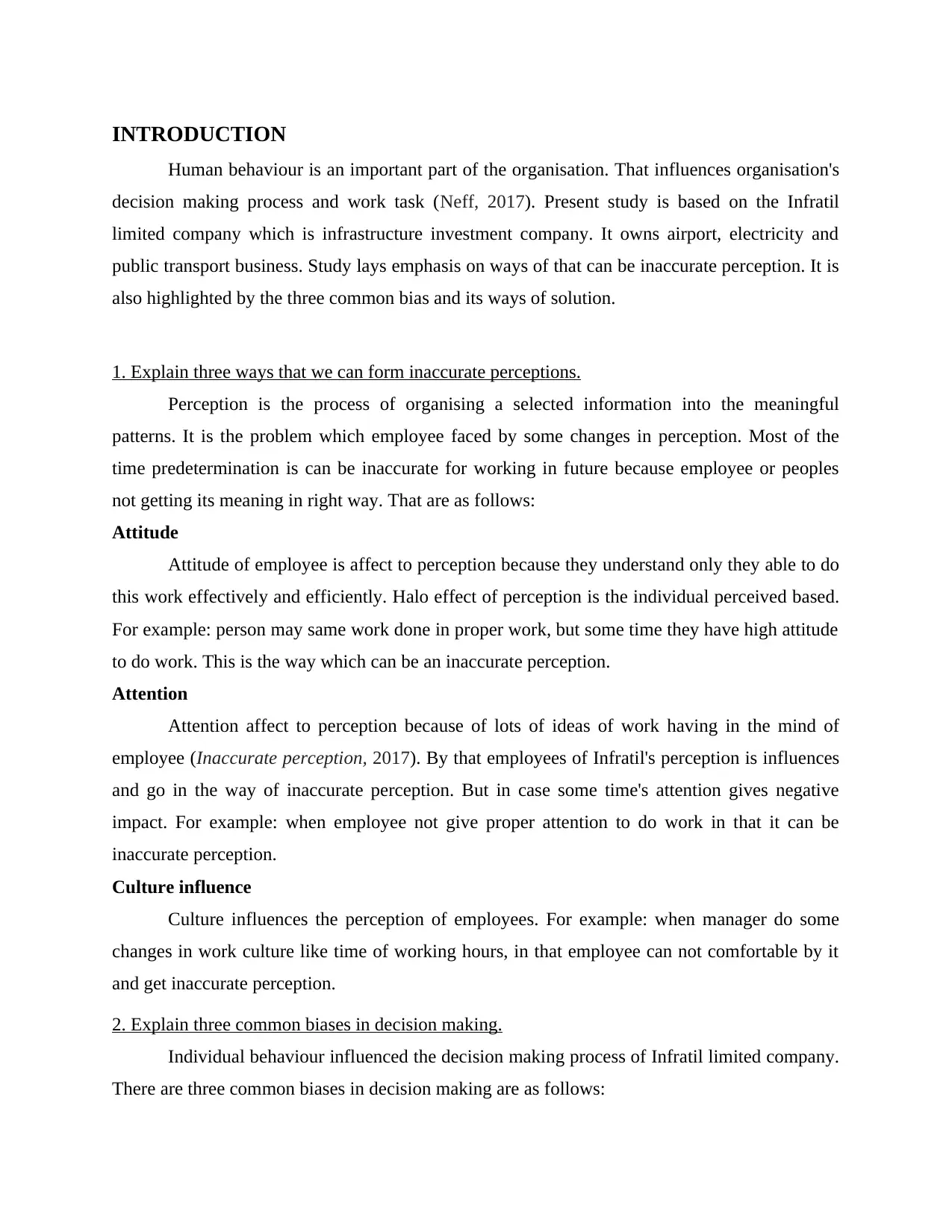
INTRODUCTION
Human behaviour is an important part of the organisation. That influences organisation's
decision making process and work task (Neff, 2017). Present study is based on the Infratil
limited company which is infrastructure investment company. It owns airport, electricity and
public transport business. Study lays emphasis on ways of that can be inaccurate perception. It is
also highlighted by the three common bias and its ways of solution.
1. Explain three ways that we can form inaccurate perceptions.
Perception is the process of organising a selected information into the meaningful
patterns. It is the problem which employee faced by some changes in perception. Most of the
time predetermination is can be inaccurate for working in future because employee or peoples
not getting its meaning in right way. That are as follows:
Attitude
Attitude of employee is affect to perception because they understand only they able to do
this work effectively and efficiently. Halo effect of perception is the individual perceived based.
For example: person may same work done in proper work, but some time they have high attitude
to do work. This is the way which can be an inaccurate perception.
Attention
Attention affect to perception because of lots of ideas of work having in the mind of
employee (Inaccurate perception, 2017). By that employees of Infratil's perception is influences
and go in the way of inaccurate perception. But in case some time's attention gives negative
impact. For example: when employee not give proper attention to do work in that it can be
inaccurate perception.
Culture influence
Culture influences the perception of employees. For example: when manager do some
changes in work culture like time of working hours, in that employee can not comfortable by it
and get inaccurate perception.
2. Explain three common biases in decision making.
Individual behaviour influenced the decision making process of Infratil limited company.
There are three common biases in decision making are as follows:
Human behaviour is an important part of the organisation. That influences organisation's
decision making process and work task (Neff, 2017). Present study is based on the Infratil
limited company which is infrastructure investment company. It owns airport, electricity and
public transport business. Study lays emphasis on ways of that can be inaccurate perception. It is
also highlighted by the three common bias and its ways of solution.
1. Explain three ways that we can form inaccurate perceptions.
Perception is the process of organising a selected information into the meaningful
patterns. It is the problem which employee faced by some changes in perception. Most of the
time predetermination is can be inaccurate for working in future because employee or peoples
not getting its meaning in right way. That are as follows:
Attitude
Attitude of employee is affect to perception because they understand only they able to do
this work effectively and efficiently. Halo effect of perception is the individual perceived based.
For example: person may same work done in proper work, but some time they have high attitude
to do work. This is the way which can be an inaccurate perception.
Attention
Attention affect to perception because of lots of ideas of work having in the mind of
employee (Inaccurate perception, 2017). By that employees of Infratil's perception is influences
and go in the way of inaccurate perception. But in case some time's attention gives negative
impact. For example: when employee not give proper attention to do work in that it can be
inaccurate perception.
Culture influence
Culture influences the perception of employees. For example: when manager do some
changes in work culture like time of working hours, in that employee can not comfortable by it
and get inaccurate perception.
2. Explain three common biases in decision making.
Individual behaviour influenced the decision making process of Infratil limited company.
There are three common biases in decision making are as follows:
⊘ This is a preview!⊘
Do you want full access?
Subscribe today to unlock all pages.

Trusted by 1+ million students worldwide
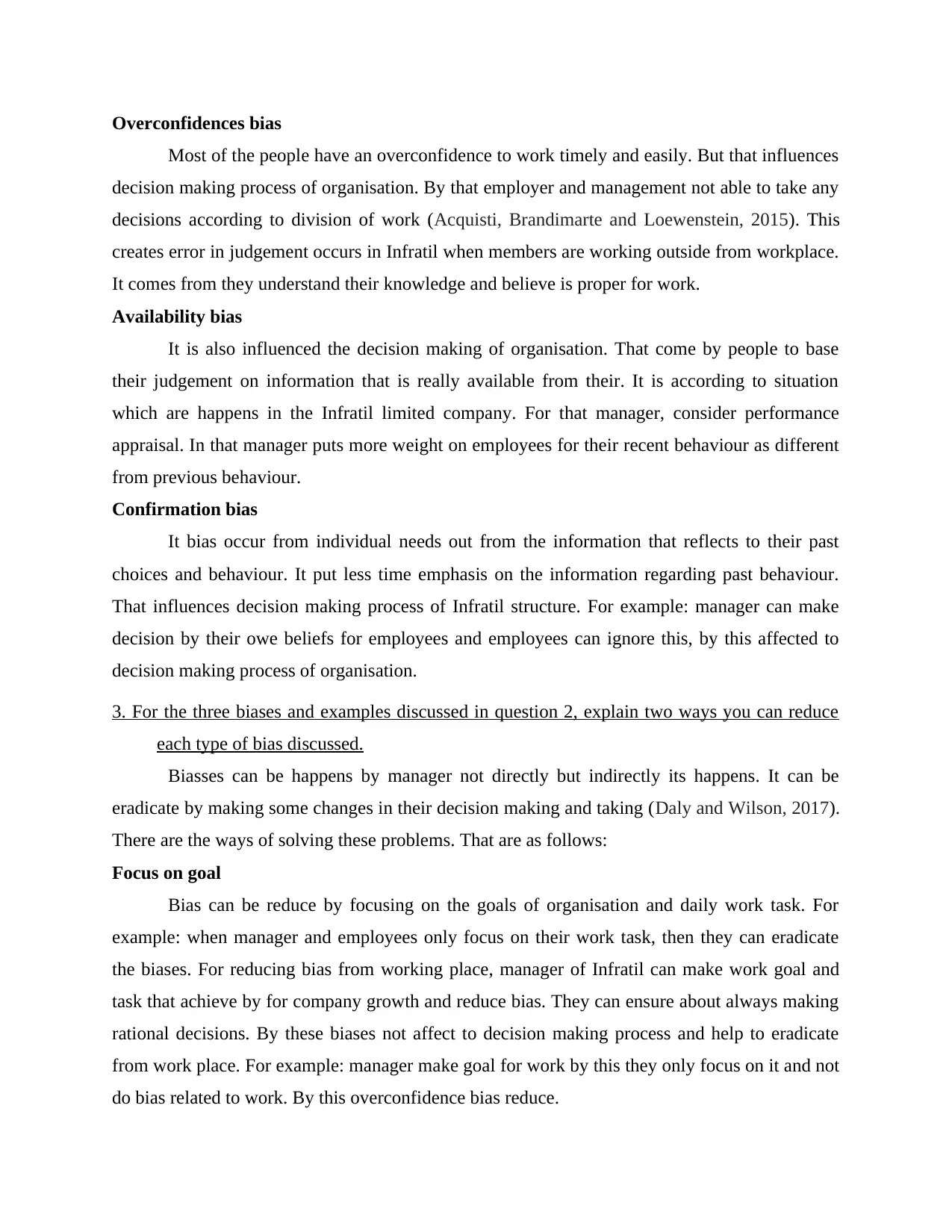
Overconfidences bias
Most of the people have an overconfidence to work timely and easily. But that influences
decision making process of organisation. By that employer and management not able to take any
decisions according to division of work (Acquisti, Brandimarte and Loewenstein, 2015). This
creates error in judgement occurs in Infratil when members are working outside from workplace.
It comes from they understand their knowledge and believe is proper for work.
Availability bias
It is also influenced the decision making of organisation. That come by people to base
their judgement on information that is really available from their. It is according to situation
which are happens in the Infratil limited company. For that manager, consider performance
appraisal. In that manager puts more weight on employees for their recent behaviour as different
from previous behaviour.
Confirmation bias
It bias occur from individual needs out from the information that reflects to their past
choices and behaviour. It put less time emphasis on the information regarding past behaviour.
That influences decision making process of Infratil structure. For example: manager can make
decision by their owe beliefs for employees and employees can ignore this, by this affected to
decision making process of organisation.
3. For the three biases and examples discussed in question 2, explain two ways you can reduce
each type of bias discussed.
Biasses can be happens by manager not directly but indirectly its happens. It can be
eradicate by making some changes in their decision making and taking (Daly and Wilson, 2017).
There are the ways of solving these problems. That are as follows:
Focus on goal
Bias can be reduce by focusing on the goals of organisation and daily work task. For
example: when manager and employees only focus on their work task, then they can eradicate
the biases. For reducing bias from working place, manager of Infratil can make work goal and
task that achieve by for company growth and reduce bias. They can ensure about always making
rational decisions. By these biases not affect to decision making process and help to eradicate
from work place. For example: manager make goal for work by this they only focus on it and not
do bias related to work. By this overconfidence bias reduce.
Most of the people have an overconfidence to work timely and easily. But that influences
decision making process of organisation. By that employer and management not able to take any
decisions according to division of work (Acquisti, Brandimarte and Loewenstein, 2015). This
creates error in judgement occurs in Infratil when members are working outside from workplace.
It comes from they understand their knowledge and believe is proper for work.
Availability bias
It is also influenced the decision making of organisation. That come by people to base
their judgement on information that is really available from their. It is according to situation
which are happens in the Infratil limited company. For that manager, consider performance
appraisal. In that manager puts more weight on employees for their recent behaviour as different
from previous behaviour.
Confirmation bias
It bias occur from individual needs out from the information that reflects to their past
choices and behaviour. It put less time emphasis on the information regarding past behaviour.
That influences decision making process of Infratil structure. For example: manager can make
decision by their owe beliefs for employees and employees can ignore this, by this affected to
decision making process of organisation.
3. For the three biases and examples discussed in question 2, explain two ways you can reduce
each type of bias discussed.
Biasses can be happens by manager not directly but indirectly its happens. It can be
eradicate by making some changes in their decision making and taking (Daly and Wilson, 2017).
There are the ways of solving these problems. That are as follows:
Focus on goal
Bias can be reduce by focusing on the goals of organisation and daily work task. For
example: when manager and employees only focus on their work task, then they can eradicate
the biases. For reducing bias from working place, manager of Infratil can make work goal and
task that achieve by for company growth and reduce bias. They can ensure about always making
rational decisions. By these biases not affect to decision making process and help to eradicate
from work place. For example: manager make goal for work by this they only focus on it and not
do bias related to work. By this overconfidence bias reduce.
Paraphrase This Document
Need a fresh take? Get an instant paraphrase of this document with our AI Paraphraser
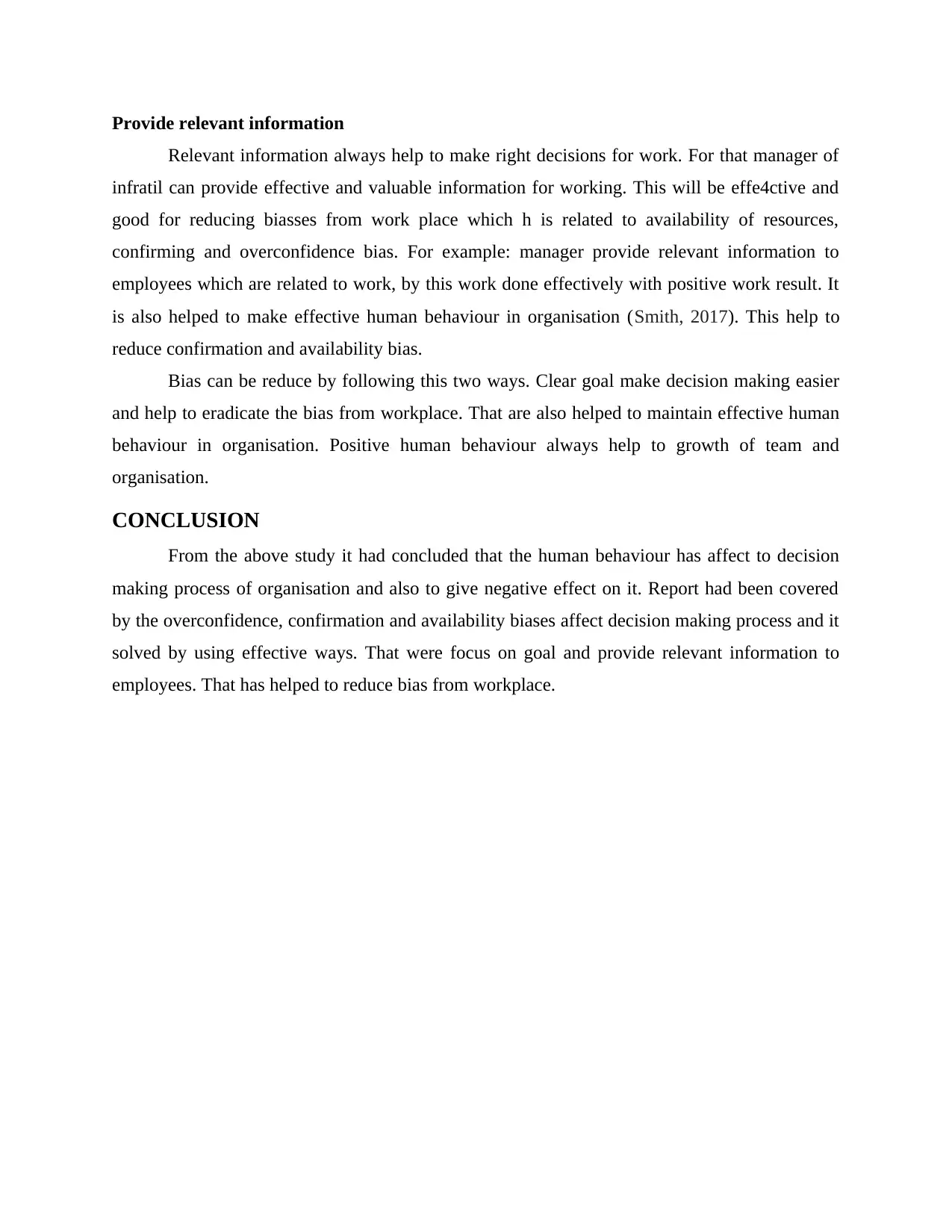
Provide relevant information
Relevant information always help to make right decisions for work. For that manager of
infratil can provide effective and valuable information for working. This will be effe4ctive and
good for reducing biasses from work place which h is related to availability of resources,
confirming and overconfidence bias. For example: manager provide relevant information to
employees which are related to work, by this work done effectively with positive work result. It
is also helped to make effective human behaviour in organisation (Smith, 2017). This help to
reduce confirmation and availability bias.
Bias can be reduce by following this two ways. Clear goal make decision making easier
and help to eradicate the bias from workplace. That are also helped to maintain effective human
behaviour in organisation. Positive human behaviour always help to growth of team and
organisation.
CONCLUSION
From the above study it had concluded that the human behaviour has affect to decision
making process of organisation and also to give negative effect on it. Report had been covered
by the overconfidence, confirmation and availability biases affect decision making process and it
solved by using effective ways. That were focus on goal and provide relevant information to
employees. That has helped to reduce bias from workplace.
Relevant information always help to make right decisions for work. For that manager of
infratil can provide effective and valuable information for working. This will be effe4ctive and
good for reducing biasses from work place which h is related to availability of resources,
confirming and overconfidence bias. For example: manager provide relevant information to
employees which are related to work, by this work done effectively with positive work result. It
is also helped to make effective human behaviour in organisation (Smith, 2017). This help to
reduce confirmation and availability bias.
Bias can be reduce by following this two ways. Clear goal make decision making easier
and help to eradicate the bias from workplace. That are also helped to maintain effective human
behaviour in organisation. Positive human behaviour always help to growth of team and
organisation.
CONCLUSION
From the above study it had concluded that the human behaviour has affect to decision
making process of organisation and also to give negative effect on it. Report had been covered
by the overconfidence, confirmation and availability biases affect decision making process and it
solved by using effective ways. That were focus on goal and provide relevant information to
employees. That has helped to reduce bias from workplace.
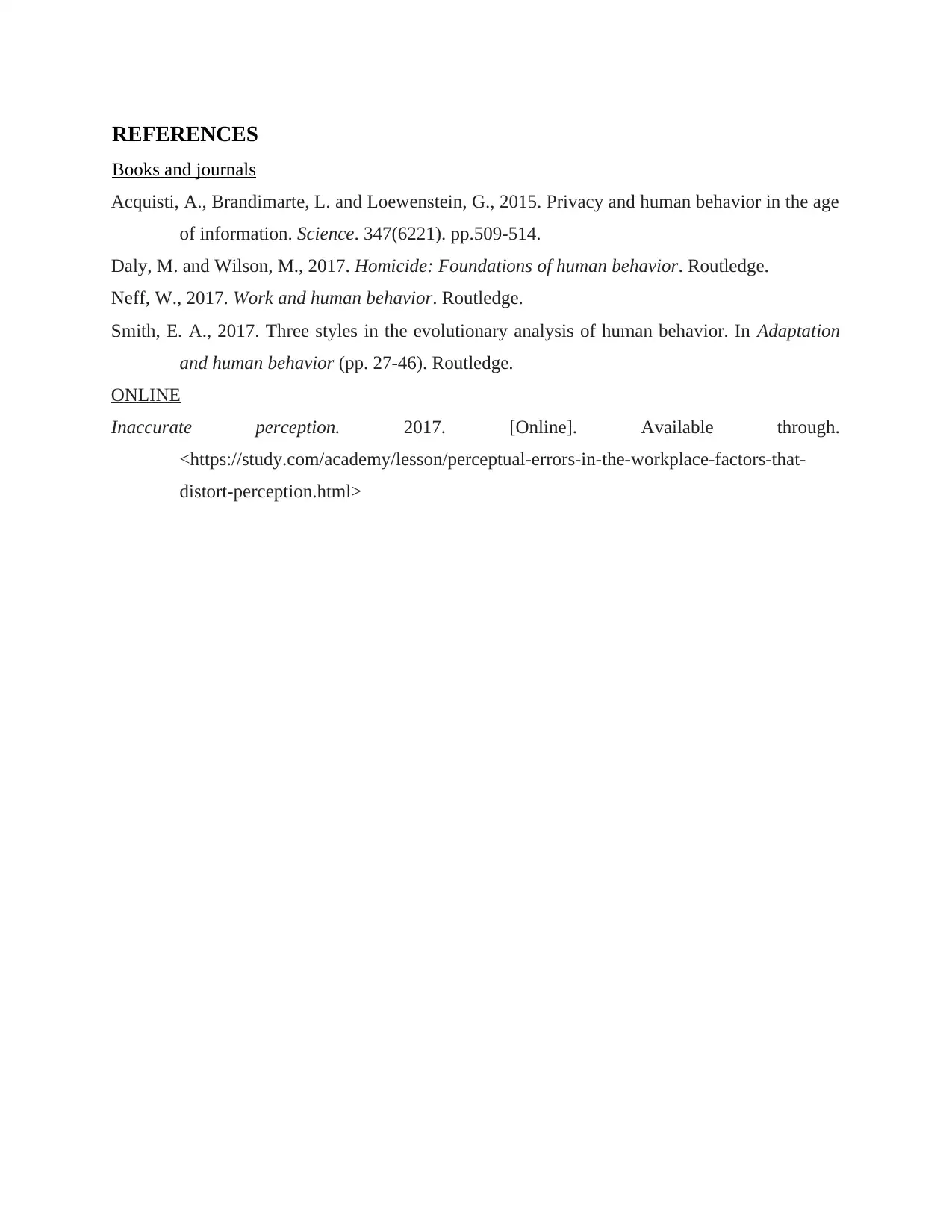
REFERENCES
Books and journals
Acquisti, A., Brandimarte, L. and Loewenstein, G., 2015. Privacy and human behavior in the age
of information. Science. 347(6221). pp.509-514.
Daly, M. and Wilson, M., 2017. Homicide: Foundations of human behavior. Routledge.
Neff, W., 2017. Work and human behavior. Routledge.
Smith, E. A., 2017. Three styles in the evolutionary analysis of human behavior. In Adaptation
and human behavior (pp. 27-46). Routledge.
ONLINE
Inaccurate perception. 2017. [Online]. Available through.
<https://study.com/academy/lesson/perceptual-errors-in-the-workplace-factors-that-
distort-perception.html>
Books and journals
Acquisti, A., Brandimarte, L. and Loewenstein, G., 2015. Privacy and human behavior in the age
of information. Science. 347(6221). pp.509-514.
Daly, M. and Wilson, M., 2017. Homicide: Foundations of human behavior. Routledge.
Neff, W., 2017. Work and human behavior. Routledge.
Smith, E. A., 2017. Three styles in the evolutionary analysis of human behavior. In Adaptation
and human behavior (pp. 27-46). Routledge.
ONLINE
Inaccurate perception. 2017. [Online]. Available through.
<https://study.com/academy/lesson/perceptual-errors-in-the-workplace-factors-that-
distort-perception.html>
⊘ This is a preview!⊘
Do you want full access?
Subscribe today to unlock all pages.

Trusted by 1+ million students worldwide
1 out of 6
Related Documents
Your All-in-One AI-Powered Toolkit for Academic Success.
+13062052269
info@desklib.com
Available 24*7 on WhatsApp / Email
![[object Object]](/_next/static/media/star-bottom.7253800d.svg)
Unlock your academic potential
Copyright © 2020–2025 A2Z Services. All Rights Reserved. Developed and managed by ZUCOL.





